The Deck
For those of you who missed last week’s article and in order to discuss some slight modifications from last week’s list, here’s the ELVES! deck I played to the top slot at a local Standard tournament:
19 Forest
1 Pendelhaven
4 Mutavault
4 Boreal Druid
4 Llanowar Elves
4 Heritage Druid
4 Bramblewood Paragon
4 Gilt-Leaf Ambush
4 Hunting Triad
4 Elvish Promenade
4 Overrun
4 Coat of Arms
Sideboard:
4 Squall Line
4 Harmonize
4 Door of Destinies
3 Primal Command
In conversations with a number of people – most notably Grand Prix: Philly Top 8 competitor Ben Wienburg, but also the forum posters in last week’s article like kj_4247 – I decided that Bramblewood Paragon was a better maindeck inclusion than Imperious Perfect. It did offer up the slight downside of not interacting that well with your 12 Elf Druids (the one-drops) like Imperious Perfect, but the benefits outweighed the negatives. First and foremost it makes your curve much smoother allowing you to mulligan less aggressively to a mana Elf and increasing the number of hands you can keep. Second, it has as equally large a target on its head as Imperious Perfect, but its side effect can last longer. Imperfect needs at least an extra 1G and a turn to start pumping out 1/1 Elf Warriors (the additional generic in its mana cost, the Green to activate, and the turn to lose summoning sickness) before you get a lasting bonus from the 2/2. Paragon, on the other hand, costs less and can immediately provide +1/+1 counters on your Elf Warrior tokens the moment you play the generators, as early as the same turn you play Paragon. That creates a more immediate and lasting effect and after a lot more testing ole’ Brambles definitely feels correct.
The other major change came from the sideboard after Cedric Phillips and Ben (Wienburg) mentioned they didn’t think the Mono-Red matchup was very good. Initially I assumed they meant “decks with Sulfurous Blast” but when they said specifically they meant the burn deck Hiromasa Imagawa played to 9-0 at Grand Prix: Shizuoka I decided to do some testing of my own. I quickly came to the same conclusion they did. Unlike many other creature-based decks in the format (though the Mono-Red Burn is more accurately a “deck with creatures” since it’s not really based around them like Doran or even Warriors) MRB doesn’t care that your creatures are significantly larger than its own. After all, they’ll be spending their turns sending instants and sorceries straight to your head and avoiding blocking or attacking altogether. They also had the spot removal to deal with any potentially critical early drops and even had a Wrath in the form of Sulfurous Blast maindeck. After testing I realized the matchup did need to be addressed in the sideboard.
A few suggestions came in that included the standby in Dragon’s Claw, but Kyle Mechler, a fellow Iowan and the owner/operator of the public forum we use to stay in touch statewide, offered up Primal Command. At first I thought it was a bit of a reach. Five mana, after all, was a bit pricey even if you got 7 life and something else out of the deal. I quickly came to the conclusion, however, that Command could take the spot of Krosan Grip for answering Teferi’s Moat and other problem enchantments/artifacts via the Plow Under effect. It could also tutor up Bramblewood Paragon or Heritage Druid, and even created a loop whereby you could continue cycling through your entire deck thanks to the reshuffling ability. I tested some sideboarded games and came to the conclusion that Primal Command was the woman for the job, quickly replacing the Krosan Grips. The matchup still wasn’t great, but it wasn’t utter trash either and I was pretty satisfied. For those keeping track at home, I eventually decided to sideboard 4 Harmonize and 3 Primal Command in for the matchup while taking out 4 Overrun and 3 Elvish Promenade. I tried other configurations that brought in Doors and/or cut some of the smaller creatures, but I’m pretty satisfied with the Commands and the card that digs you to the Command. I’m not completely sure it’s correct, but it seems pretty reasonable.
The Tournament
Battlezone Games in industrial Cedar Rapids, Iowa, home to the Quaker Oats mill where a young Ashton Kutcher once toiled away before hitting it big, was hosting a small Standard tournament for a mere $5 entry (for all our European readers out there $5 works out to about the amount you pay for complimentary condiments at the local McDonald’s). I decided to make the quick jog up Interstate 380 to give the Elf deck a twirl after trying an FNM the week before in my native Iowa City. I didn’t expect a PTQ caliber challenge, which isn’t to say, of course, that I thought the tournament would be a cakewalk. On the contrary, I knew nearly all of the players who showed up, some with their own home brews, others playing tech straight from the StarCityGames.com database, and while I respected a number of the competitors in regards to mental stress and battle conditions, the local Standard tournament on a Saturday afternoon just can’t hold up to slogging through 8 rounds against the best of the Midwest after driving all the way to Madison (or Minneapolis, Chicago, Kansas City, St. Louis…). Twelve players showed up to battle for the top prize Tarmogoyf as well various promo foils and store credit. Here’s how my tournament went:
Round 1: Chris Lottch with UB Aggro
Chris is a player from my hometown store in Iowa City, and we had played the previous weekend at the FNM for which I had randomly turned up. He’s the type of person whose pseudo-gruff exterior belies the fact that he’s a real nice guy with which to simply talk, and a few weeks back he forayed to his first PTQ up in Minneapolis. Nothing is more exciting to me than new players experiencing the PTQ circuit, as they are the lifeblood of the competitive community.
Game 1: Chris gets off to a rough start, landing a turn 2 Dauthi Slayer but playing little else of relevance (including a third land). He also didn’t have access to his Blue, cutting off most of the cards in his hands anyway. I kept a solid hand and led with a Heritage Druid, a Bramblewood Paragon (which he evoked a Shriekmaw to remove), a second Heritage Druid, an Elvish Promenade for two tokens, then killed him on turn 5 with Overrun.
I wasn’t quite sure how to sideboard against Chris. I knew the previous weekend he had been ready with Damnations in his sideboard, but I wasn’t certain whether I was playing against the exact same deck (the previous week’s deck seemed a lot more controlling). In the end I opted to leave the deck as it was, figuring even if I lost the second game to Wraths I’d have time to adjust for game 3.
Game 2: He opened on a mulligan but had a much more aggressive start in the form of a Flying Men, which quickly picked up an Unstable Mutation and then was joined by Dauthi Slayer. He also had the time to evoke a Shriekmaw on my Heritage Druid, but a first turn Llanowar Elves allowed me to power out a sneaky Paragon (after he had blown his Shriekmaw) that turned up a triple set of 2/2 Elf Warriors thanks to Hunting Triad. While his clock was aggressive and evasive, mine was simply more aggressive, and a Coat of Arms round about turn 5 or 6 was more than lethal while I stood at a healthy 6 life.
Chris lamented that he hadn’t been able to find one of his three copies of Damnation against me, which means he DID board them in. Whoops.
1-0
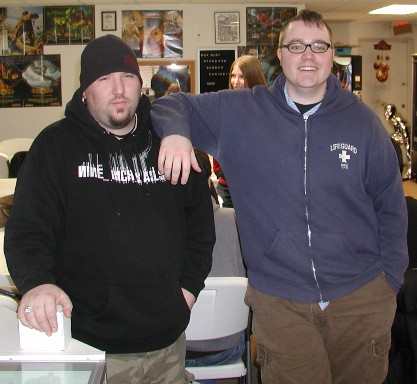
My round 1 opponent Chris Lottch
Round 2: Patrick Kennedy with Doran
Patrick is also from the Iowa City area and has begun traveling to PTQs with Chris from round 1. He’s been playing Doran for a while now so I felt I knew what I would be facing, and while it’s normally a good matchup you never want to take anything for granted.
Game 1: Patrick spent the early turns pinging himself with a variety of lands like Llanowar Wastes, Brushland, and Murmuring Bosk. He got an early hit with Doran while I built my team up through mana Elves. Eventually I maneuvered a huge turn with Heritage Druid and Coat of Arms and things got confusing. My Coat was on the table with two Elf Warriors and three Elf Druids in Llanowar Elves, Heritage Druid, and Boreal Druid. Patrick had Treefolk Harbinger (Treefolk Druid) and Doran (Treefolk Shaman), but it seemed pretty apparent he was confused about how the Coat worked. First he didn’t apply it to his creatures, then he didn’t realize his Treefolk Druids were actually making my mana Elves slightly larger than they would have been otherwise. That may have in part been due to the fact his Harbinger was in Japanese and because my Llanowar Elves were all pre-Ninth Edition so they had the creature type “Elves” or “Elf” instead of “Elf Druid,” but in any case after a ten minute explanation things were cleared up and I managed to swing for the win through his blockers.
I decided to sideboard Door of Destiny in for Overrun, but in hindsight that feels like a mistake. I think the better play would have been to board in Harmonize for Overrun to make sure my hand stayed juiced in the face of his removal.
Game 2: His first turn Thoughtseize nailed my Door of Destiny, making my hand a sadder mix of just Elves and token generators. I built up a small army but he managed to do the same with Doran, Shriekmaw, and Birds of Paradise. I wasn’t able to go on the offensive very often as I was in a position where I needed to keep my Elves around long enough to kill him if I ripped Coat of Arms. Between his lands and a few early attacks I had whittled his life to just 10, but he had a massive force getting through to me, and at 2 life he gave me one turn to hit any of four outs in the form of Coat of Arms. I moved to my draw step, flipped over the top card of my deck… and bashed in with 8+ ridiculously large/ridiculously large Elves.
2-0

Man, this guy…
Round 3: RJ Milos with UW Control/Reveillark
Mr. Milos had just managed to qualify for the statewide City Champs tournament the weekend prior where he met Blu McFarlane in the finals where Blu was playing the very Elf deck I was. Fortunately they split so RJ didn’t have to battle it out, and I got to write about a success story with the deck after only being able to try a small test run at a Friday Night Magic myself.
Game 1: RJ was playing a homebrew UW Control/Reveillark type deck. I don’t believe he had the combo but he did play heavier amounts of control, like Mana Tithe maindeck. I didn’t realize that until the second game when he blew me out with one, but the first the game played out exactly as you want it to against Reveillark. I won the roll and here’s how it went:
My turn 1: Llanowar Elves
His turn 1: Adarkar Wastes, go.
My turn 2: Gilt-Leaf Ambush mainphase to prevent Rune Snag.
His turn 2: Snow-Covered Island, go.
My turn 3: Elvish Promenade for three tokens, attack for 2 putting it 20-18 in my favor.
His turn 3: Evoke Mulldrifter.
I simply revealed the Forest and Coat in my hand and politely explained I was going to kill him on my turn because he was tapped out and there was nothing he could do about it. RJ, after getting over a slight bit of surprise at losing on turn 4, promptly conceded to save time, and we moved to the second.
On Friday night this week I stopped by Critical Hit Games, the local shop, to pick up some cards I needed for this tournament. While there a local player named Lewk, who made the top 4 of the tournament I’m writing about in this very article, asked me how I sideboarded the ELVES! deck against UW Reveillark, especially in the face of hate like Crovax. I told him I wasn’t completely sure. I posted the sideboarding guide last week (review with the link at the top of the page) but I’m not sure boarding in Harmonize to help get through Wrath is correct. Because Reveillark is a control deck with a combo win, you actually need to beat them quickly and rely heavily on the turn 4 hands. Against RJ I decided to simply leave my deck as it was to determine what type of hate he had before bringing anything in.
Game 2: I opened on a small beater hand with Bramblewood Paragon, Llanowar Elves, Boreal Druid, and Mutavault. The creature-lands are actually very key in beating decks like UW because they don’t have many answers to the things maindeck. RJ, of course, had Urza’s Factory and Faerie Conclave to help block them through Wrath, but I stuck with the traditional Green plan for beating Blue by landing six power of creatures and simply attacking until he found Wrath. Naturally he had it on turn 4, and I began to rebuild with a Hunting Triad and Gilt-Leaf Ambush. At 13 life RJ stabilized with some sideboard hate as he tapped five mana for a Teferi’s Moat set to Green.
That sent me into the tank for a moment. Moat is a card I’ve been prepared to beat (remember the Primal Commands in the sideboard?), but hadn’t boarded to do so. Even though Moat was bad it wasn’t game over, as I still had a Mutavault on the table. Being as RJ had tapped out to resolve his Moat, I landed a Coat of Arms on my turn and was able to attack with my Mutavault thanks to a mana Elf and charged in for 6 damage. The following turn I was able to put him to 2, but an Aven Riftwatcher crawled him back into it, a Mana Tithe snagged a Gilt-Leaf Ambush unexpectedly, and after a few more turns of Drifting through Mulls and a Reveillark it was my turn to scoop to save time.
I opted to sideboard in my Squall Lines over Overrun as I felt it would give me a better chance to defeat Moat. Primal Command seemed awfully mopey against a deck with as many counters as RJ had, but an instant speed Fireball that Wrathed his team seemed pretty good as RJ continually spent as much of his mana on my turn as possible, and I knew if I could get him low enough he wouldn’t be expecting the Squall.
Game 3: In the third game I opened on a five-land hand but two of the lands were Mutavaults and the other two cards were Bramblewood Paragon and Coat of Arms, so I kept. The Paragon got in early to drop him to 16 before he used up removal on it. That opened the way for my Mutavaults to get in, and all the land I was drawing was actually a good thing as it allowed me to attack with my Grizzly Bear lands as well as play the occasional Gilt-Leaf Ambush. At 11 life he managed to land his Teferi’s Moat again, but I simply untapped, played a Coat of Arms, and attacked with TWO Mutavaults dealing a total of 10 damage to him and leaving him at 1. That shut off his Adarkar Wastes, and even though he had managed to shut down my Elves from attacking, RJ spent his turn looking through his hand before packing the match in with a sigh and a handshake.
3-0
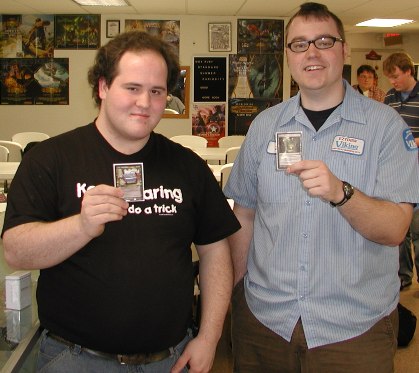
The card that almost got him there, and the card that DID get me there.
Round 4: Jason Dlouhy with the $1,000 Special
Jason is a player for whom I have a great deal of respect, as a community member and as a competitor. Secretly I wish he’d go to more events and step up to the next level with some PTQs, but if he’s happy playing the local tournaments then more power to him. We opted to ID to lock ourselves into the Top 4 then played out the match for fun. His deck is a combination of the priciest cards in Standard in BGW, and features hits like Tarmogoyf, Garruk, Bitterblossom, and Profane Command amongst others. He felt the matchup was terrible for him, but he beat me in three games (though I didn’t sideboard so as not to give away how I would do so in the Top 8).
3-0-1
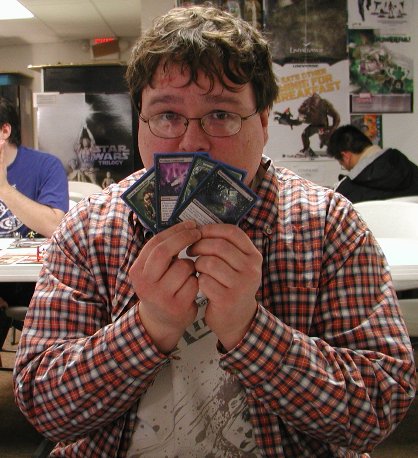
His deck cost slightly more than his first car. True story.
The top 4 featured four different archetypes including me with ELVES!, Jason Dlouhy with the $1,000 Special, Chris Freed with UB Faeries, and the Lewk I spoke of earlier with a homebrew RG mana ramp Wild Pair list.
Semifinals: Chris Freed with UB Faeries
Chris is a med student of some type at the University of Iowa and is a semi-regular at the Iowa City FNMs and Tuesday night drafts. He was seriously bemoaning his fate to be facing off against me, as he considered ELVES! to be a terrible matchup.
Game 1: I lost the roll but he had only a Faerie Conclave after begging for an Island into Ancestral Visions start. I had Boreal Druid into Bramblewood Paragon and Mutavault, then a Gilt-Leaf Ambush in response to Chris’ Nameless Inversion on my Paragon, and a turn 5 Overrun. He had a board full of mana at that point with an Ancestral Visions about to go off, but after doing some math he quickly demonstrated he didn’t have any counters to stop my lethal sorcery and scooped ‘em up.
I sideboarded my set of Squall Lines for the Overruns.
Game 2: He had a pretty aggressive early start with a Spellstutter Sprite while I built my board up with a few mana Elves and some Mutavaults. I didn’t have a token generator, unfortunately, and when at three cards he attempted to Vendilion Clique me during my draw step I simply Squall Lined for 1, killing both of his creatures (the Clique and a Spellstutter) and losing my Coat of Arms to the 3/1’s ability. Even with the extra draw, however, I wasn’t able to find a token generator and I could only attack with some mana Elves, dropping him to 11. The following turn I drew a second Coat of Arms but he had added Bitterblossom to the table and I faced a conundrum: play my Coat and risk losing to his air force but potentially get ahead if I drew a Triad, Ambush, or Promenade, or hold the Coat and lose to his ever-growing team. Decisions, decisions…
I opted to play the Coat but naturally drew blanks for the following three turns, and his Faerie Rogue tokens quickly turned lethal and took it home.
Game 3: Chris had to mulligan and I had a pretty unforgiving start, with a Llanowar Elves into Boreal Druid into Hunting Triad despite having missed a land drop. He had a Rune Snag when I went for a Coat of Arms, but I had played so many mana Elves that I had enough to pay for it and my 7/7 tokens quickly made mincemeat out of his considerably smaller fliers.
4-0-1
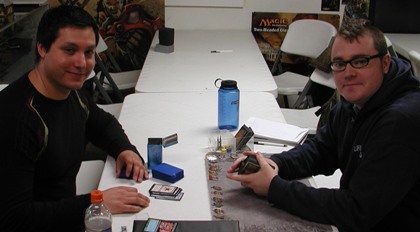
Notch one for Elves in the tribal wars
Finals: Jason Dlouhy with the $1,000 Special
Jason again with his $1,000 bad-matchup-against-ELVES! (or so he claimed).
Game 1: Jason won the roll but opened on a double mulligan. My hand was six non-lands and a Forest, but with double Paragon and double Gilt-Leaf Ambush I agonized over whether I should keep. With JD down two cards and me on the draw I determined that I had a better than 50% chance to hit a mana source in two draw steps (23 lands and 8 mana Elves remaining) so I decided to keep and risk it. Sure enough I hit Boreal Druid on turn 1, and though I missed my second land drop for one turn I was able to power out a Paragon then the second enhanced by the first. Jason, as one would imagine, struggled to keep up when I got to three mana and started cranking out 3/3 Elf Warrior tokens. Eventually three mana sources turned into four and a Hunting Triad, and by the time I got to five for Coat of Arms Jason could see the writing on the wall and promptly packed it in.
During sideboarding I opted to bring in my Harmonizes for Overrun. Jason had plenty of spot removal and some discard, and I felt a card like Overrun, which I had to hold until I was in a position to win with it instead of just running it onto the table like I could with Coat, was a liability. Furthermore, on an empty board his draws were often better than mine as a Tarmogoyf or Doran are considerably larger than a Llanowar Elves or an Elvish Promenade with zero tokens out. Adding a great draw like Harmonize promised to make things much, much easier for me if such a situation were to arise.
Game 2: For our second duel it was Jason’s turn to come out of the gates, and he did exactly that with a Birds of Paradise landing him a second turn Doran. He followed that up with a Garruk that enabled Tarmogoyf with the land untap ability, and I struggled to find token generators that would allow me to keep up. Things turned much worse when he found a Bitterblossom to keep up with any tokens I could muster, and while I was Harmonizing my way into answers Jason calmly played a Profane Command to soak up a chunk of my life and fear his team in for the win.
Game 3: For the final game of the tournament it was back to being my turn for a blazing start, and my deck did not fail me. A Llanowar Elves led to a Boreal Druid led to a turn 3 Hunting Triad. Jason had managed to Thoughtseize my Coat of Arms on the first turn, but I managed to rip consecutive Elvish Promenades and all of a sudden some 15 1/1s were looking particularly threatening regardless of not being enhanced. Jason tried to stabilize with a Bitterblossom to keep up with the hordes, but he was quickly swarmed and victory was mine…
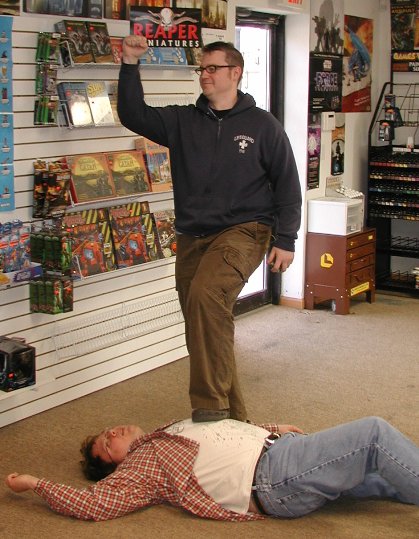
Victory is mine!
I left Battlezone with a victory, an extra Tarmogoyf, and some promo DCI foils. Most importantly I had had the chance to play a few matches with the ELVES! deck to add to what I had played the previous week at FNM. Now neither tournament is a true test of the deck’s ability to win, but because there are no PTQs that are Standard right now and because the Regionals won’t happen until after Shadowmoor I felt some type of test was in order. ELVES! definitely has the hallmarks of a very good beatdown deck. Its best hand puts an opponent dead on turn 3 or (more often) 4, and it has resiliency to the cards which are the worst for it (Damnation, Wrath, Sulfurous Blast, etc.). It also has some excellent sideboard options, and I do believe it might actually be the real deal.
Still, it does sometimes struggle against UW Reveillark, and certainly the Mono-Red Burn concoction, but I think it’s reasonable to expect it to become a staple in Standard. Perhaps that’s being a bit overzealous but I suppose time will tell. Before we go today, a few important lessons on the deck I’ve learned over the past few weeks.
Coat can be such a challenging card to play. It might seem pretty simple to understand at face value, but once you’ve played it a few times it becomes pretty clear why players sometimes run afoul of understanding it. First and foremost it’s a universal effect, meaning your opponent’s creatures are getting benefits in addition to yours. Normally you’re way ahead in the specific creature types department, but sometimes you get anomalistic games in which they’re somehow ahead, generally by way of Bitterblossom, and playing Coat is actually a bad idea.
Of course, because it is a universal effect your Elves, Warriors, and Druids all get bonuses from your opponent’s Elves, Warriors, and Druids. This is relevant in, say, a Doran matchup where your unsuspecting opponent fails to realize their own Treefolk Harbinger is actually making all of your mana Elves +1/+1 (it’s a Druid). With the new tournament guidelines from the DCI you’re not actually required to explain to your opponent what your creature’s power and toughness is, which gives you the edge with Coat (provided you’ve done your testing). While you’re not allowed to lie about the power and toughness of your attacking creatures, you don’t have to answer specific questions about their stats. That means it’s on your opponent to correctly recognize that each creature gets +1/+1 for all other creatures sharing a type, not just the ones you control, and that the opponent’s creatures are also benefitting.
There are additional sticky points for the Coat. Llanowar Elves for example is an “Elf Druid” but didn’t receive that text in its creature type box until Ninth Edition. That means if you’re playing pre-Ninth copies of the card it’s up to your opponent to remember the Elf has a class type as well as a creature type, recognizing that the thing is slightly larger than it appears when they control something like the aforementioned Treefolk Harbinger.
Changeling is also a big deal with Coat of Arms, as the creatures who have the static ability essentially get +1/+1 for every single creature in play. That’s most relevant when your opponent has Mutavault and from time to time it can be wrong to tap out all of your creatures to play a Coat when it potentially leaves them bashing with a lethal Mutavault that you weren’t paying attention to. Remember that your own copies of the creature-land can serve to pump the whole team even when you’re not able to attack with the animated version of the land. All you have to do is activate it before damage goes on the stack and you’ve got yourself a Glorious Anthem mid way through combat. Of course, it does the same thing for your opponent’s creatures so remember not to get hurt by it more than you’re helped.
Did you know that Coat actually protects ELVES! from losing to the Reveillark combo? Forum user bretblair recently started this helpful thread to point out that cards like Elvish Champion, Goblin King, and Coat of Arms all stop Mirror Entity from wiping out the Reveillark player’s team. How? It’s pretty simple, yet devious. Mirror Entity activates to make all of the controller’s creatures 0/0s until end of turn. It also makes them all creature types and when state based effects are checked the game sees a static effect (the Champion, King, Coat, etc.) giving each of those creatures +1/+1 over the 0/0 the Entity attempted to make them. This means Body Double can’t keep dying and stops the combo entirely. In a good game against Reveillark they’ll be dead long before they combo, but thanks to bretblair for posting publicly that Coat of Arms will stop them from comboing you.
Finally, a clear explanation of the Coat to hopefully address any lasting concerns. Coat of Arms essentially asks every creature on the table to look at each other creature and ask the question “Do I share at least one creature type with this creature?” If the answer is yes the Coat will give the creature +1/+1. It does not matter how many creature types beyond the first that the two critters share as the question only cares about whether they share something. It’s been a while since yours truly was in Logic 101 but if I recall correctly it’s an “If… than” statement. Shout out on the forums if that’s incorrect, but in any case if a creature shares one or more types with another creature it will get +1/+1 via the Coat.
Bill Stark
billtriesagain@hotmail.com

